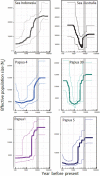Sponge diversification in marine lakes: Implications for phylogeography and population genomic studies on sponges
- PMID: 37066063
- PMCID: PMC10099488
- DOI: 10.1002/ece3.9945
Sponge diversification in marine lakes: Implications for phylogeography and population genomic studies on sponges
Abstract
The relative influence of geography, currents, and environment on gene flow within sessile marine species remains an open question. Detecting subtle genetic differentiation at small scales is challenging in benthic populations due to large effective population sizes, general lack of resolution in genetic markers, and because barriers to dispersal often remain elusive. Marine lakes can circumvent confounding factors by providing discrete and replicated ecosystems. Using high-resolution double digest restriction-site-associated DNA sequencing (4826 Single Nucleotide Polymorphisms, SNPs), we genotyped populations of the sponge Suberites diversicolor (n = 125) to test the relative importance of spatial scales (1-1400 km), local environmental conditions, and permeability of seascape barriers in shaping population genomic structure. With the SNP dataset, we show strong intralineage population structure, even at scales <10 km (average F ST = 0.63), which was not detected previously using single markers. Most variation was explained by differentiation between populations (AMOVA: 48.8%) with signatures of population size declines and bottlenecks per lake. Although the populations were strongly structured, we did not detect significant effects of geographic distance, local environments, or degree of connection to the sea on population structure, suggesting mechanisms such as founder events with subsequent priority effects may be at play. We show that the inclusion of morphologically cryptic lineages that can be detected with the COI marker can reduce the obtained SNP set by around 90%. Future work on sponge genomics should confirm that only one lineage is included. Our results call for a reassessment of poorly dispersing benthic organisms that were previously assumed to be highly connected based on low-resolution markers.
Keywords: Porifera; RADseq; Suberites diversicolor; genetic resolution; marine biodiversity; seascape genomics.
© 2023 The Authors. Ecology and Evolution published by John Wiley & Sons Ltd.
Conflict of interest statement
The authors declare no conflict of interest.
Figures




Similar articles
-
Phylogeography of the sponge Suberites diversicolor in Indonesia: insights into the evolution of marine lake populations.PLoS One. 2013 Oct 1;8(10):e75996. doi: 10.1371/journal.pone.0075996. eCollection 2013. PLoS One. 2013. PMID: 24098416 Free PMC article.
-
Rapid divergence of mussel populations despite incomplete barriers to dispersal.Mol Ecol. 2018 Apr;27(7):1556-1571. doi: 10.1111/mec.14556. Mol Ecol. 2018. PMID: 29575349
-
Genetic differentiation and signatures of local adaptation revealed by RADseq for a highly dispersive mud crab Scylla olivacea (Herbst, 1796) in the Sulu Sea.Ecol Evol. 2021 May 4;11(12):7951-7969. doi: 10.1002/ece3.7625. eCollection 2021 Jun. Ecol Evol. 2021. PMID: 34188864 Free PMC article.
-
Interocean patterns in shallow water sponge assemblage structure and function.Biol Rev Camb Philos Soc. 2020 Dec;95(6):1720-1758. doi: 10.1111/brv.12637. Epub 2020 Aug 19. Biol Rev Camb Philos Soc. 2020. PMID: 32812691 Review.
-
Sponge ecology in the molecular era.Adv Mar Biol. 2012;61:345-410. doi: 10.1016/B978-0-12-387787-1.00006-4. Adv Mar Biol. 2012. PMID: 22560781 Review.
Cited by
-
Evolution of Chromosomal Inversions across an Avian Radiation.Mol Biol Evol. 2024 Jun 1;41(6):msae092. doi: 10.1093/molbev/msae092. Mol Biol Evol. 2024. PMID: 38743589 Free PMC article.
-
Shifts in dominance of benthic communities along a gradient of water temperature and turbidity in tropical coastal ecosystems.PeerJ. 2024 Apr 22;12:e17132. doi: 10.7717/peerj.17132. eCollection 2024. PeerJ. 2024. PMID: 38666078 Free PMC article.
-
Connectivity and Adaptation Patterns of the Deep-Sea Ground-Forming Sponge Geodia hentscheli Across Its Entire Distribution.Mol Biol Evol. 2025 Jul 1;42(7):msaf145. doi: 10.1093/molbev/msaf145. Mol Biol Evol. 2025. PMID: 40476758 Free PMC article.
References
-
- Allendorf, F. W. , Hohenlohe, P. A. , & Luikart, G. (2010). Genomics and the future of conservation genetics. Nature Reviews Genetics, 11(10), 697–709. - PubMed
-
- Altschul, S. F. , Gish, W. , Miller, W. , Myers, E. W. , & Lipman, D. J. (1990). Basic local alignment search tool. Journal of Molecular Biology, 215(3), 403–410. - PubMed
-
- Avise, J. C. (2000). Phylogeography: The history and formation of species. Harvard University Press.
-
- Avise, J. C. (2009). Phylogeography: Retrospect and prospect. Journal of Biogeography, 36(1), 3–15.
-
- Azzini, F. , Calcinai, B. , Cerrano, C. , Bavestrello, G. , & Pansini, M. (2007). Sponges of the marine karst lakes and of the coast of the islands of Ha Long Bay (North Vietnam). In Custodia M. R., Lobo‐Hajdu G., Hajdu E., & Muricy G. (Eds.), Porifera research: Biodiversity innovation and sustainability (pp. 157–164). Museu Nacional, Universidade Federal do Rio de Janeiro.
Associated data
Grants and funding
LinkOut - more resources
Full Text Sources
Miscellaneous

